CHEVROLET COBALT 2007 1.G Owners Manual
Manufacturer: CHEVROLET, Model Year: 2007, Model line: COBALT, Model: CHEVROLET COBALT 2007 1.GPages: 450, PDF Size: 2.48 MB
Page 271 of 450
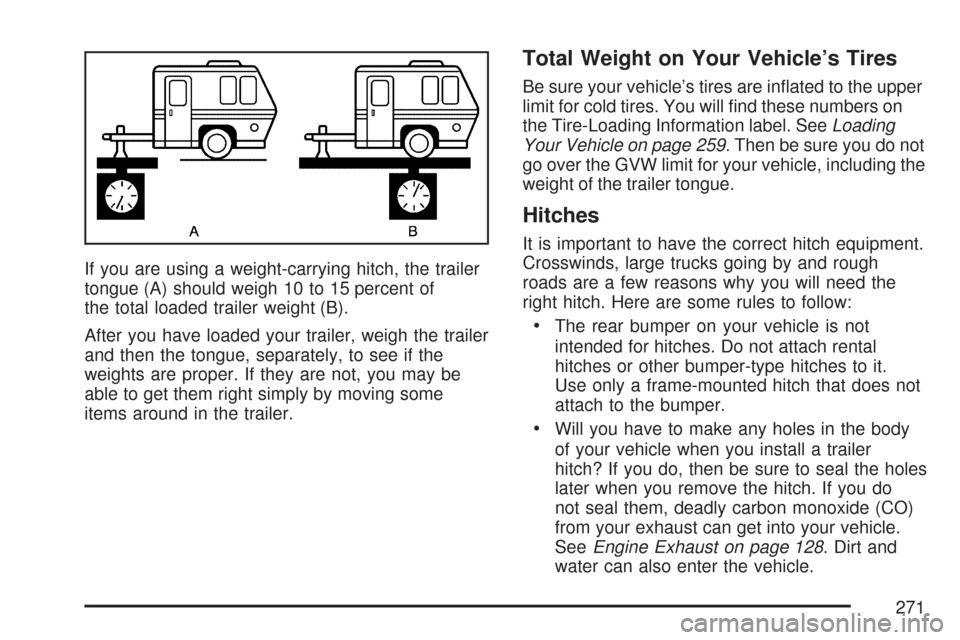
If you are using a weight-carrying hitch, the trailer
tongue (A) should weigh 10 to 15 percent of
the total loaded trailer weight (B).
After you have loaded your trailer, weigh the trailer
and then the tongue, separately, to see if the
weights are proper. If they are not, you may be
able to get them right simply by moving some
items around in the trailer.
Total Weight on Your Vehicle’s Tires
Be sure your vehicle’s tires are in�ated to the upper
limit for cold tires. You will �nd these numbers on
the Tire-Loading Information label. SeeLoading
Your Vehicle on page 259. Then be sure you do not
go over the GVW limit for your vehicle, including the
weight of the trailer tongue.
Hitches
It is important to have the correct hitch equipment.
Crosswinds, large trucks going by and rough
roads are a few reasons why you will need the
right hitch. Here are some rules to follow:
The rear bumper on your vehicle is not
intended for hitches. Do not attach rental
hitches or other bumper-type hitches to it.
Use only a frame-mounted hitch that does not
attach to the bumper.
Will you have to make any holes in the body
of your vehicle when you install a trailer
hitch? If you do, then be sure to seal the holes
later when you remove the hitch. If you do
not seal them, deadly carbon monoxide (CO)
from your exhaust can get into your vehicle.
SeeEngine Exhaust on page 128. Dirt and
water can also enter the vehicle.
271
Page 272 of 450
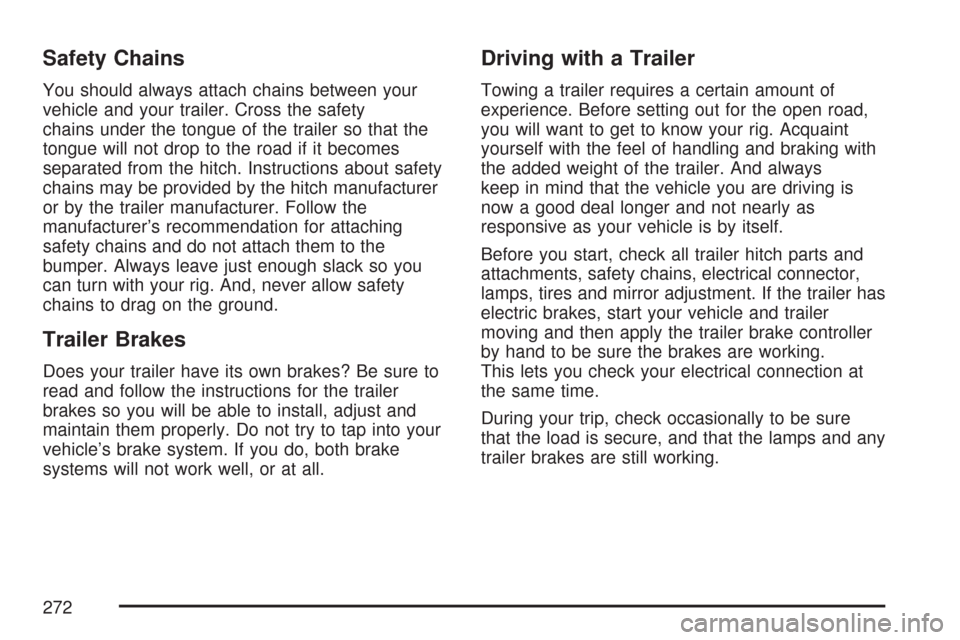
Safety Chains
You should always attach chains between your
vehicle and your trailer. Cross the safety
chains under the tongue of the trailer so that the
tongue will not drop to the road if it becomes
separated from the hitch. Instructions about safety
chains may be provided by the hitch manufacturer
or by the trailer manufacturer. Follow the
manufacturer’s recommendation for attaching
safety chains and do not attach them to the
bumper. Always leave just enough slack so you
can turn with your rig. And, never allow safety
chains to drag on the ground.
Trailer Brakes
Does your trailer have its own brakes? Be sure to
read and follow the instructions for the trailer
brakes so you will be able to install, adjust and
maintain them properly. Do not try to tap into your
vehicle’s brake system. If you do, both brake
systems will not work well, or at all.
Driving with a Trailer
Towing a trailer requires a certain amount of
experience. Before setting out for the open road,
you will want to get to know your rig. Acquaint
yourself with the feel of handling and braking with
the added weight of the trailer. And always
keep in mind that the vehicle you are driving is
now a good deal longer and not nearly as
responsive as your vehicle is by itself.
Before you start, check all trailer hitch parts and
attachments, safety chains, electrical connector,
lamps, tires and mirror adjustment. If the trailer has
electric brakes, start your vehicle and trailer
moving and then apply the trailer brake controller
by hand to be sure the brakes are working.
This lets you check your electrical connection at
the same time.
During your trip, check occasionally to be sure
that the load is secure, and that the lamps and any
trailer brakes are still working.
272
Page 273 of 450

Following Distance
Stay at least twice as far behind the vehicle ahead
as you would when driving your vehicle without
a trailer. This can help you avoid situations
that require heavy braking and sudden turns.
Passing
You will need more passing distance up ahead
when you are towing a trailer. And, because
the vehicle is a good deal longer, you will need to
go much farther beyond the passed vehicle
before you can return to your lane.
Backing Up
Hold the bottom of the steering wheel with one
hand. Then, to move the trailer to the left,
just move that hand to the left. To move the trailer
to the right, move your hand to the right. Always
back up slowly and, if possible, have someone
guide you.
Making Turns
Notice:Making very sharp turns while
trailering could cause the trailer to come in
contact with the vehicle. Your vehicle could be
damaged. Avoid making very sharp turns
while trailering.
When you are turning with a trailer, make wider
turns than normal. Do this so your trailer will
not strike soft shoulders, curbs, road signs,
trees or other objects. Avoid jerky or sudden
maneuvers. Signal well in advance.
273
Page 274 of 450
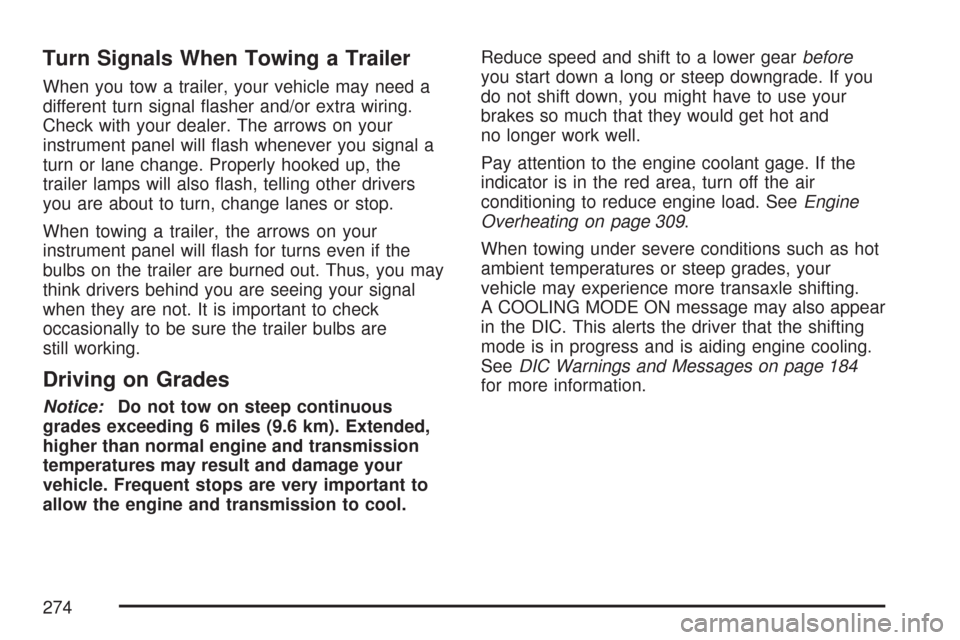
Turn Signals When Towing a Trailer
When you tow a trailer, your vehicle may need a
different turn signal �asher and/or extra wiring.
Check with your dealer. The arrows on your
instrument panel will �ash whenever you signal a
turn or lane change. Properly hooked up, the
trailer lamps will also �ash, telling other drivers
you are about to turn, change lanes or stop.
When towing a trailer, the arrows on your
instrument panel will �ash for turns even if the
bulbs on the trailer are burned out. Thus, you may
think drivers behind you are seeing your signal
when they are not. It is important to check
occasionally to be sure the trailer bulbs are
still working.
Driving on Grades
Notice:Do not tow on steep continuous
grades exceeding 6 miles (9.6 km). Extended,
higher than normal engine and transmission
temperatures may result and damage your
vehicle. Frequent stops are very important to
allow the engine and transmission to cool.Reduce speed and shift to a lower gearbefore
you start down a long or steep downgrade. If you
do not shift down, you might have to use your
brakes so much that they would get hot and
no longer work well.
Pay attention to the engine coolant gage. If the
indicator is in the red area, turn off the air
conditioning to reduce engine load. SeeEngine
Overheating on page 309.
When towing under severe conditions such as hot
ambient temperatures or steep grades, your
vehicle may experience more transaxle shifting.
A COOLING MODE ON message may also appear
in the DIC. This alerts the driver that the shifting
mode is in progress and is aiding engine cooling.
SeeDIC Warnings and Messages on page 184
for more information.
274
Page 275 of 450
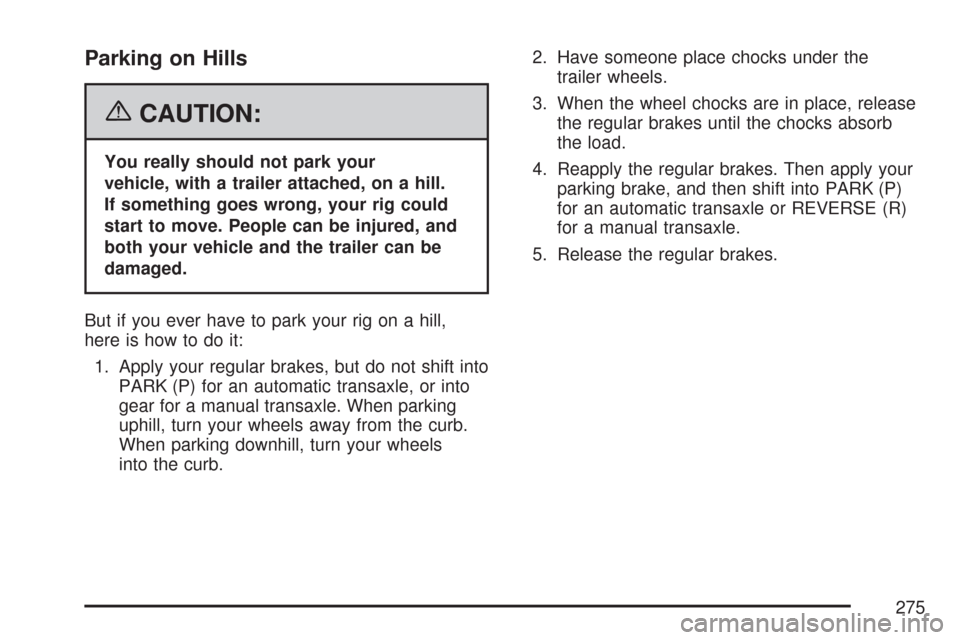
Parking on Hills
{CAUTION:
You really should not park your
vehicle, with a trailer attached, on a hill.
If something goes wrong, your rig could
start to move. People can be injured, and
both your vehicle and the trailer can be
damaged.
But if you ever have to park your rig on a hill,
here is how to do it:
1. Apply your regular brakes, but do not shift into
PARK (P) for an automatic transaxle, or into
gear for a manual transaxle. When parking
uphill, turn your wheels away from the curb.
When parking downhill, turn your wheels
into the curb.2. Have someone place chocks under the
trailer wheels.
3. When the wheel chocks are in place, release
the regular brakes until the chocks absorb
the load.
4. Reapply the regular brakes. Then apply your
parking brake, and then shift into PARK (P)
for an automatic transaxle or REVERSE (R)
for a manual transaxle.
5. Release the regular brakes.
275
Page 276 of 450
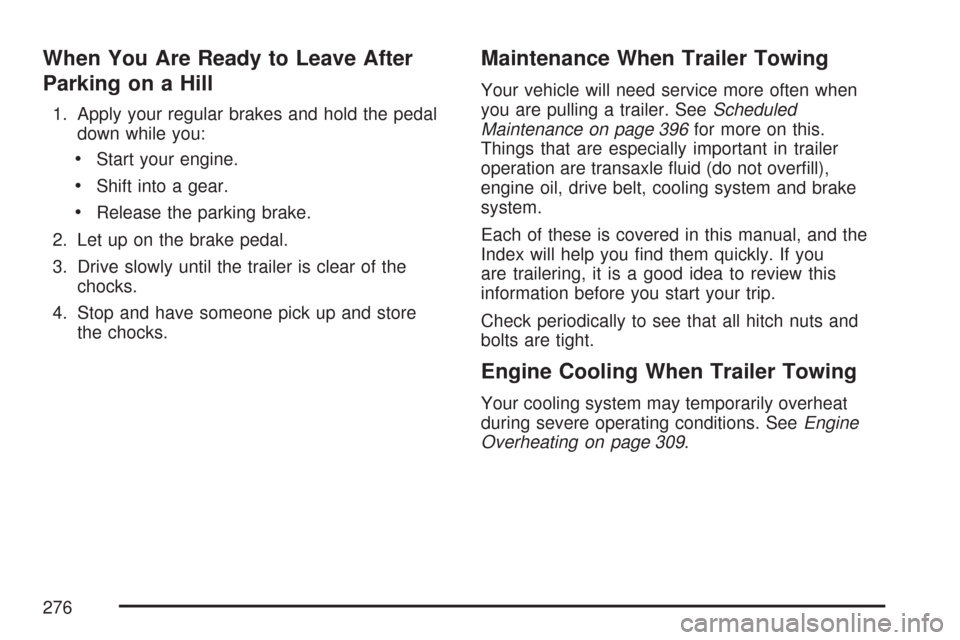
When You Are Ready to Leave After
Parking on a Hill
1. Apply your regular brakes and hold the pedal
down while you:
Start your engine.
Shift into a gear.
Release the parking brake.
2. Let up on the brake pedal.
3. Drive slowly until the trailer is clear of the
chocks.
4. Stop and have someone pick up and store
the chocks.
Maintenance When Trailer Towing
Your vehicle will need service more often when
you are pulling a trailer. SeeScheduled
Maintenance on page 396for more on this.
Things that are especially important in trailer
operation are transaxle �uid (do not over�ll),
engine oil, drive belt, cooling system and brake
system.
Each of these is covered in this manual, and the
Index will help you �nd them quickly. If you
are trailering, it is a good idea to review this
information before you start your trip.
Check periodically to see that all hitch nuts and
bolts are tight.
Engine Cooling When Trailer Towing
Your cooling system may temporarily overheat
during severe operating conditions. SeeEngine
Overheating on page 309.
276
Page 277 of 450
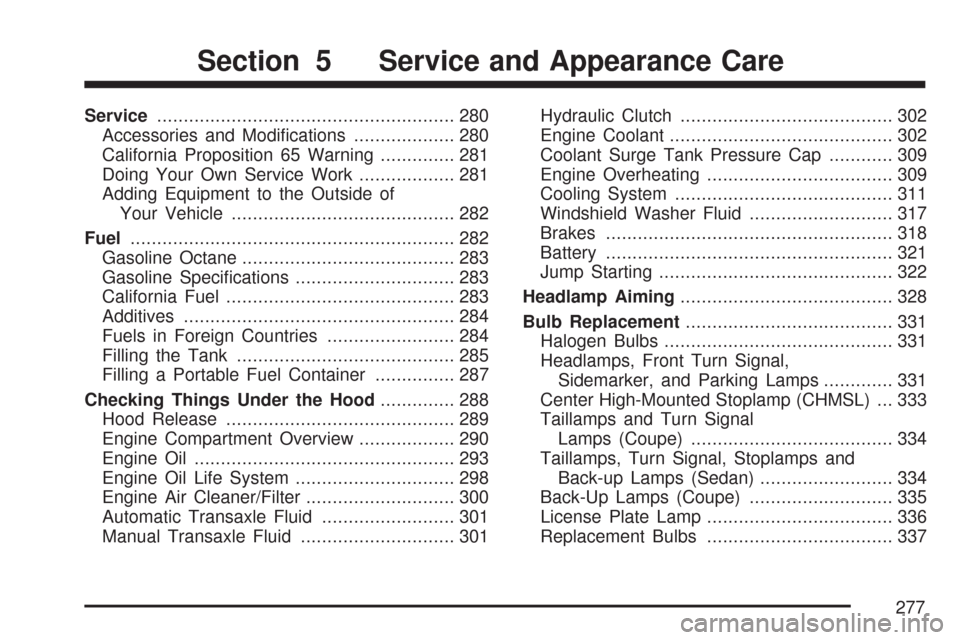
Service........................................................ 280
Accessories and Modi�cations................... 280
California Proposition 65 Warning.............. 281
Doing Your Own Service Work.................. 281
Adding Equipment to the Outside of
Your Vehicle.......................................... 282
Fuel............................................................. 282
Gasoline Octane........................................ 283
Gasoline Speci�cations.............................. 283
California Fuel........................................... 283
Additives................................................... 284
Fuels in Foreign Countries........................ 284
Filling the Tank......................................... 285
Filling a Portable Fuel Container............... 287
Checking Things Under the Hood.............. 288
Hood Release........................................... 289
Engine Compartment Overview.................. 290
Engine Oil................................................. 293
Engine Oil Life System.............................. 298
Engine Air Cleaner/Filter............................ 300
Automatic Transaxle Fluid......................... 301
Manual Transaxle Fluid............................. 301Hydraulic Clutch........................................ 302
Engine Coolant.......................................... 302
Coolant Surge Tank Pressure Cap............ 309
Engine Overheating................................... 309
Cooling System......................................... 311
Windshield Washer Fluid........................... 317
Brakes...................................................... 318
Battery...................................................... 321
Jump Starting............................................ 322
Headlamp Aiming........................................ 328
Bulb Replacement....................................... 331
Halogen Bulbs........................................... 331
Headlamps, Front Turn Signal,
Sidemarker, and Parking Lamps............. 331
Center High-Mounted Stoplamp (CHMSL) ... 333
Taillamps and Turn Signal
Lamps (Coupe)...................................... 334
Taillamps, Turn Signal, Stoplamps and
Back-up Lamps (Sedan)......................... 334
Back-Up Lamps (Coupe)........................... 335
License Plate Lamp................................... 336
Replacement Bulbs................................... 337
Section 5 Service and Appearance Care
277
Page 278 of 450
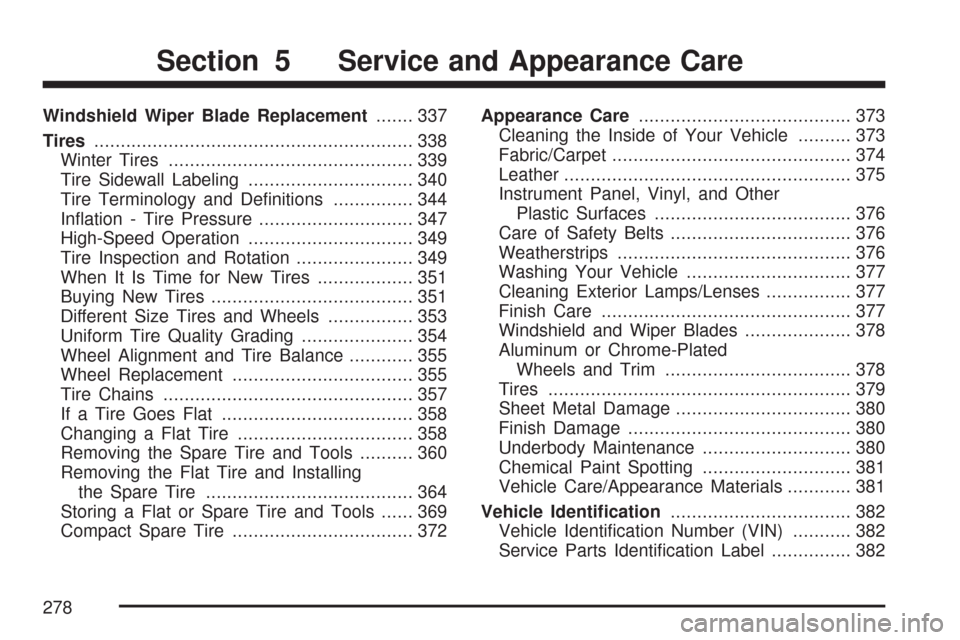
Windshield Wiper Blade Replacement....... 337
Tires............................................................ 338
Winter Tires.............................................. 339
Tire Sidewall Labeling............................... 340
Tire Terminology and De�nitions............... 344
In�ation - Tire Pressure............................. 347
High-Speed Operation............................... 349
Tire Inspection and Rotation...................... 349
When It Is Time for New Tires.................. 351
Buying New Tires...................................... 351
Different Size Tires and Wheels................ 353
Uniform Tire Quality Grading..................... 354
Wheel Alignment and Tire Balance............ 355
Wheel Replacement.................................. 355
Tire Chains............................................... 357
If a Tire Goes Flat.................................... 358
Changing a Flat Tire................................. 358
Removing the Spare Tire and Tools.......... 360
Removing the Flat Tire and Installing
the Spare Tire....................................... 364
Storing a Flat or Spare Tire and Tools...... 369
Compact Spare Tire.................................. 372Appearance Care........................................ 373
Cleaning the Inside of Your Vehicle.......... 373
Fabric/Carpet............................................. 374
Leather...................................................... 375
Instrument Panel, Vinyl, and Other
Plastic Surfaces..................................... 376
Care of Safety Belts.................................. 376
Weatherstrips............................................ 376
Washing Your Vehicle............................... 377
Cleaning Exterior Lamps/Lenses................ 377
Finish Care............................................... 377
Windshield and Wiper Blades.................... 378
Aluminum or Chrome-Plated
Wheels and Trim................................... 378
Tires......................................................... 379
Sheet Metal Damage................................. 380
Finish Damage.......................................... 380
Underbody Maintenance............................ 380
Chemical Paint Spotting............................ 381
Vehicle Care/Appearance Materials............ 381
Vehicle Identi�cation.................................. 382
Vehicle Identi�cation Number (VIN)........... 382
Service Parts Identi�cation Label............... 382
Section 5 Service and Appearance Care
278
Page 279 of 450
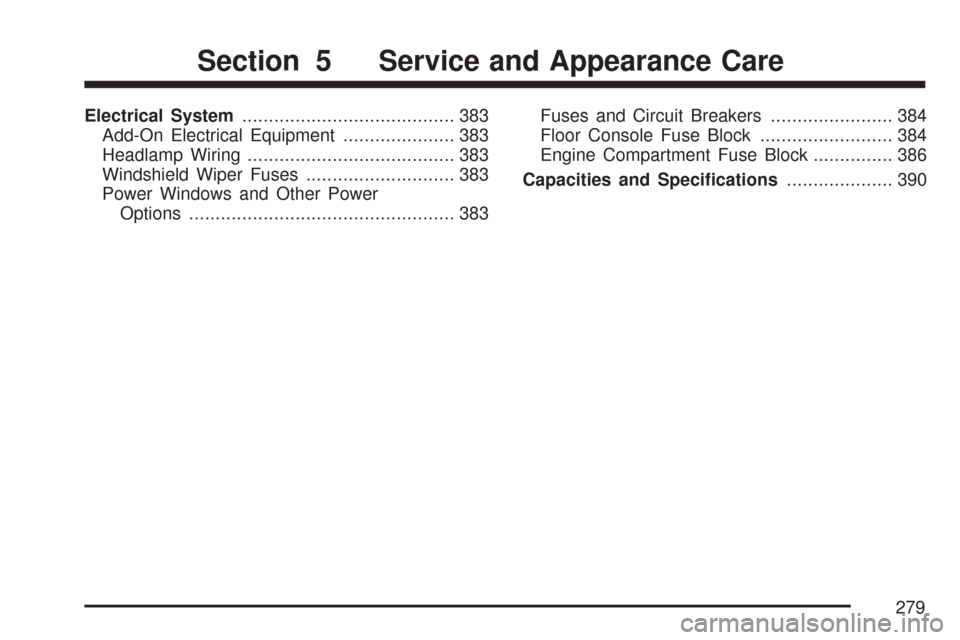
Electrical System........................................ 383
Add-On Electrical Equipment..................... 383
Headlamp Wiring....................................... 383
Windshield Wiper Fuses............................ 383
Power Windows and Other Power
Options.................................................. 383Fuses and Circuit Breakers....................... 384
Floor Console Fuse Block......................... 384
Engine Compartment Fuse Block............... 386
Capacities and Speci�cations.................... 390
Section 5 Service and Appearance Care
279
Page 280 of 450
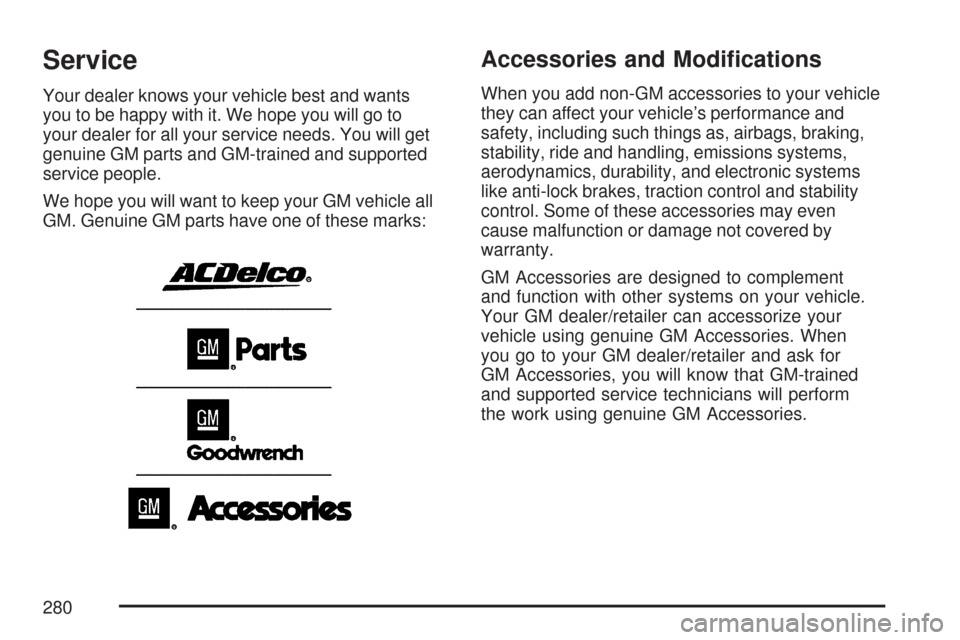
Service
Your dealer knows your vehicle best and wants
you to be happy with it. We hope you will go to
your dealer for all your service needs. You will get
genuine GM parts and GM-trained and supported
service people.
We hope you will want to keep your GM vehicle all
GM. Genuine GM parts have one of these marks:
Accessories and Modi�cations
When you add non-GM accessories to your vehicle
they can affect your vehicle’s performance and
safety, including such things as, airbags, braking,
stability, ride and handling, emissions systems,
aerodynamics, durability, and electronic systems
like anti-lock brakes, traction control and stability
control. Some of these accessories may even
cause malfunction or damage not covered by
warranty.
GM Accessories are designed to complement
and function with other systems on your vehicle.
Your GM dealer/retailer can accessorize your
vehicle using genuine GM Accessories. When
you go to your GM dealer/retailer and ask for
GM Accessories, you will know that GM-trained
and supported service technicians will perform
the work using genuine GM Accessories.
280